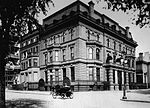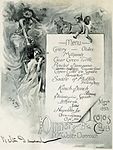45 East 66th Street (also known as 777 Madison Avenue) is a cooperative apartment building on the Upper East Side of Manhattan in New York City, United States. It was built between 1906 and 1908 and was designed by the firm of Harde & Short. The building is one of a few luxury apartment buildings that were developed in the surrounding area prior to World War I. It is a New York City designated landmark and is listed on the National Register of Historic Places.
The building, located at the northeast corner of Madison Avenue and 66th Street, is ten stories high. The facade is made of red brick, with light-colored French Gothic–style terracotta details spread across the facade. The Madison Avenue and 66th Street facades are both divided vertically into three bays and are ornamented with details such as band courses, ogee arches, finials, crockets, and tracery. Initially, the building had 20 apartments, surrounding a light court at the center; the typical apartment included three to four bedrooms and several family rooms. The ground-story apartments were replaced with retail in 1929, and the apartments were subdivided in the late 1940s and early 1950s. Over the years, architectural critics such as Paul Goldberger and Christopher Gray have praised the detailing on the facade.
The building was developed by Parkview Real Estate Company, which was led by Charles F. Rogers. The structure was sold in 1912 after going into foreclosure, and it was resold twice more in the next decade. Bing & Bing owned the building from 1929 to 1973, when the racehorse owner Sigmund Sommer bought it. Sommer fired several employees and made other changes to the building, triggering rent strikes and lawsuits. Bing & Bing ultimately repurchased 45 East 66th Street in 1977 and resold it to Martin J. Raynes in 1985. Raynes converted the building into a housing cooperative, and the facade was renovated in the late 1980s. After Raynes ended his involvement with the building in 1990, Classic Properties sponsored the co-op conversion and sold the retail space. A penthouse structure atop the building was erected in the 2010s.










